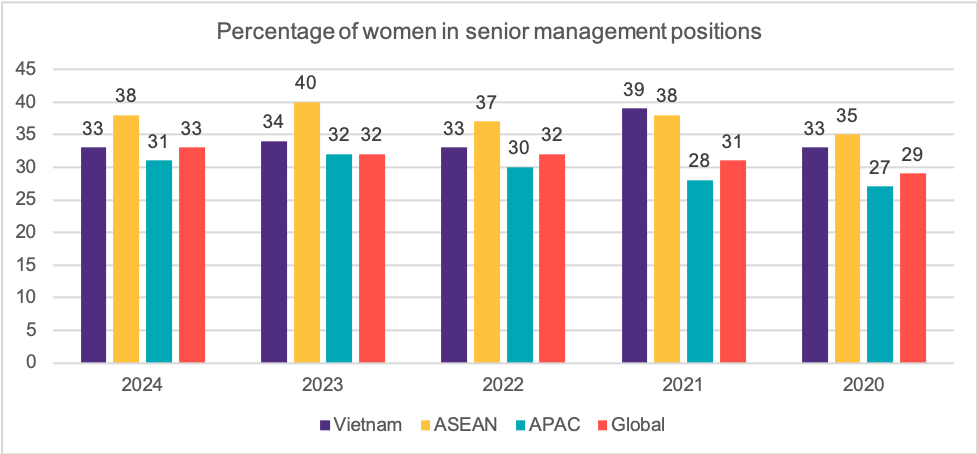By Trinh Thi Tuyet Anh, Director Business Development and International Liaison, Grant Thornton Vietnam –
In today’s rapidly evolving corporate landscape, discussions around gender equality in leadership has never been more critical. As the focus intensifies on Environment, Social, and Governance (ESG) compliance, women’s rights are becoming increasingly important. Gender equity is not solely a social objective; it intersects significantly with principles of Governance & Leadership.
As we celebrate International Women’s Day, it’s a fitting time to reflect on our progress and consider the pathways ahead in achieving gender parity in senior management within the business environment.
It is intriguing to discover that Grant Thornton’s Women in Business report 2024* is a beacon of insights garnered from two decades of dedicated research into women’s representation at the workplace.
Having spent years navigating the corporate landscape, these insights resonate deeply with me, and I believe they offer invaluable perspectives for our ongoing journey towards gender parity in leadership.
Women in Senior Management Position
Women have long fought for workplace gender equality, pushing for fair treatment, equal opportunities, and acknowledgment. Our collective efforts have yielded significant progress.
Results from Grant Thornton’s first survey indicated that women held only 19.4% of senior management roles in mid-market firms globally, but this figure has risen to 33.5%.

In Vietnam, women now hold 33% of leadership positions, while the ASEAN and APAC regions report figures of 38% and 31%, respectively. Nevertheless, in Vietnam, the number of female leaders in businesses decreased by 1 percentage point compared to the previous year.
The fact that Vietnam has yet to surpass the global benchmark and saw a decline compared to 2023 raises important questions, necessitating stronger solutions to advance gender parity in the workplace.
Role Change
As pointed out by Grant Thornton’s survey results, this year saw a significant drop in the global percentage of female CEO to 19% from 28% last year. The significant wave of CEO and leadership resignations occurred in 2022 and 2023.
When questioned about their primary reasons for departing from their positions, several female CEOs cited caregiving responsibilities and public pressure.
Specifically, they noted that the CEO role was perceived to be more suited to males due to the expectation of assertiveness and aggression, especially during times of economic uncertainty.
Gender Split of Various Senior Management Positions
Grant Thornton’s survey also provides insights into the proportion of women and men occupying management positions across various specific roles.
In Vietnam’s mid-market enterprises, several areas such as finance, marketing, sales, and human resource management have female leadership.
The percentage of CFOs, CMOs, Sales directors, and HR directors at mid-market enterprises that are female is 71%, 63%, 59%, and 79%, respectively.
The rates observed globally, as well as within the ASEAN and APAC regions, exhibit quite small variations from those found in Vietnam.
Pathways to Parity
What we have learned from Grant Thornton’s report is the highly insightful pathways to increase gender parity in leadership: appointing both a C-suite member and a female senior leader for DE&I initiatives, establishing a standalone DE&I strategy, and offering flexible work arrangements.
In Vietnam, approximately 63% of mid-market businesses report their CEO is responsible for DE&I strategies, while involvement from other C-suite members is less significant.
Thus, it’s advisable for CEOs in Vietnam’s mid-market firms to collaborate with female senior leaders in overseeing DE&I strategies to boost the number of women in senior management positions.
Conclusion
As a woman navigating the intricate dynamics of business, these findings have stirred a mix of emotions – hope for the progress we’ve achieved and a sense of determination to overcome the barriers that persist.
The report has illuminated the pathways toward inclusive leadership and underscored the importance of fostering environments where all individuals, regardless of gender, can thrive.

By Trinh Thi Tuyet Anh, Director Business Development and International Liaison, Grant Thornton Vietnam –
*Grant Thornton’s Women in Business report
For 20 years, Grant Thornton has cast a light on issues surrounding gender diversity in senior management among the world’s mid-market businesses, exposing barriers and identifying actions for change.
The 2024 report is available to read at https://www.grantthornton.global/en/insights/women-in-business/women-in-business-report/.
All views and opinions expressed on this site are those of the individual authors and comments on this site are the sole responsibility of the individual contributor.

